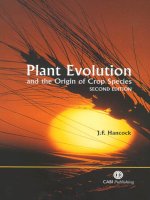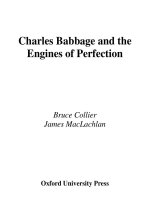- Trang chủ >>
- Khoa Học Tự Nhiên >>
- Vật lý
evolution and the levels of selection jan 2007
Bạn đang xem bản rút gọn của tài liệu. Xem và tải ngay bản đầy đủ của tài liệu tại đây (3.11 MB, 276 trang )
EVOLUTION AND THE LEVELS
OF SELECTION
This page intentionally left blank
Evolution and the
Levels of Selection
SAMIR OKASHA
CLARENDON PRESS · OXFORD
1
Great Clarendon Street, Oxford ox2 6dp
Oxford University Press is a department of the University of Oxford.
It furthers the University’s objective of excellence in research, scholarship,
and education by publishing worldwide in
Oxford New York
Auckland Cape Town Dar es Salaam Hong Kong Karachi
Kuala Lumpur Madrid Melbourne Mexico City Nairobi
New Delhi Shanghai Taipei Toronto
With offices in
Argentina Austria Brazil Chile Czech Republic France Greece
Guatemala Hungary Italy Japan Poland Portugal Singapore
South Korea Switzerland Thailand Turkey Ukraine Vietnam
Oxford is a registered trade mark of Oxford University Press
in the UK and in certain other countries
Published in the United States
by Oxford University Press Inc., New York
© Samir Okasha 2006
The moral rights of the author have been asserted
Database right Oxford University Press (maker)
First published 2006
All rights reserved. No part of this publication may be reproduced,
stored in a retrieval system, or transmitted, in any form or by any means,
without the prior permission in writing of Oxford University Press,
or as expressly permitted by law, or under terms agreed with the appropriate
reprographics rights organization. Enquiries concerning reproduction
outside the scope of the above should be sent to the Rights Department,
Oxford University Press, at the address above
You must not circulate this book in any other binding or cover
and you must impose the same condition on any acquirer
British Library Cataloguing in Publication Data
Data available
Library of Congress Cataloging in Publication Data
Data available
Typeset by Laserwords Private Limited, Chennai, India
Printed in Great Britain
on acid-free paper by
Biddles Ltd, King’s Lynn, Norfolk
ISBN 0–19–926797–9 978–0–19–926797–2
13579108642
Acknowledgements
I am grateful to numerous friends and colleagues for discussion and
correspondence, in particular Peter Godfrey-Smith, Elliott Sober, David
Sloan Wilson, John Damuth, Kim Sterelny, the late John Maynard
Smith, Jim Griesemer, the late Bill Hamilton, Ayelet Shavit, Lisa Lloyd,
Ben Kerr, Patrick Forber, Ken Reisman, Eva Jablonka, Dave Chalmers,
Rick Michod, Rob Wilson, Tom Henfrey, Rasmus Winther, Brett
Calcott, Melinda Fagan, Denis Walsh, Tim Lewens, Len Nunney,
Susanna Rinard, Paul Rainey, Alirio Rosales, James Ladyman, Sahotra
Sarkar, Alex Rosenberg, Robert Brandon, Denis Roze, Stefan Lindquist,
Bill Wimsatt, Bob Crawford, Alexander Bird, and Jonathan Grose.
I am especially grateful to those who sent me comments on all or
part of the manuscript: Lisa Lloyd, Tim Lewens, Roberta Millstein,
Peter Godfrey-Smith, Rob Wilson, Neven Sesardic, Ben Kerr, Alirio
Rosales, Ayelet Shavit, Rick Michod, and Sahotra Sarkar. I am also
grateful to audiences at the Universities of Bristol, Leeds, Austin-Texas,
Vienna, Duke, North Carolina, the London School of Economics, and
the Australian National University.
I owe a special debt to Peter Godfrey-Smith, with whom I have
discussed virtually all of the ideas in this book, often at great length,
and who provided extremely detailed feedback on each chapter, saving
me from many errors. I am also indebted to Kim Sterelny for his
encouragement and advice at all stages of the project, to Alex Rosenberg
whose lectures initially aroused my interest in philosophy of biology,
to Bill Newton-Smith who supervised my doctoral thesis, to Sahotra
Sarkar who read the manuscript for OUP, and to Peter Momtchiloff of
OUP who supported the project from the outset.
I began writing this book while based at the Instituto de Invest-
igaciones Filosoficas, National University of Mexico, whose hospitality
and financial support I gratefully acknowledge. I am also grateful to the
University of York, my former employer, for a term of sabbatical, and
to the AHRB for a period of matching leave. I am especially grateful
to The Leverhulme Trust, whose financial support enabled me to take
research leave in the year 2005–6, and to the University of Bristol,
my current employer, for granting me leave. The final manuscript was
prepared while I was a Visiting Fellow at the Research School of the
vi Acknowledgements
Social Sciences, Australian National University, to whom I am grateful
for providing a hospitable working environment. I am grateful to the
University of Chicago Press for permission to re-use material published
in Philosophy of Science 70, 2003. Finally and most of all, I am grateful
to Havi Carel for all her love and for keeping me smiling when I ran
out of words.
Samir Okasha
Bristol
March 2006
Contents—Summary
Introduction 1
1. Natural Selection in the Abstract 10
2. Selection at Multiple Levels: Concepts and Methods 40
3. Causality and Multi-Level Selection 76
4. Philosophical Issues in the Levels-of-Selection Debate 112
5. The Gene’s-Eye View and its Discontents 143
6. The Group Selection Controversy 173
7. Species Selection, Clade Selection, and Macroevolution 203
8. Levels of Selection and the Major Evolutionary Transitions 218
Bibliography 241
Index 257
This page intentionally left blank
Contents
Introduction 1
1. Natural Selection in the Abstract 10
Introduction 10
1.1 Abstract Formulations of Darwinian Principles 13
1.2 Price’s Equation 18
1.3 Interpretation of Price’s Equation 23
1.4 Statistical versus Causal Decomposition 25
1.4.1 Random Drift and Causal Decomposition 31
1.5 Price’s Equation and the Lewontin Conditions 34
2. Selection at Multiple Levels: Concepts and Methods 40
Introduction 40
2.1 Hierarchical Organization 40
2.2 Selection at Multiple Levels: Key Concepts 46
2.2.1 Particle Characters and Collective Characters 48
2.2.2 Life Cycles 49
2.2.3 Particle Fitness and Collective Fitness 53
2.2.4 The Two Types of Multi-Level Selection 56
2.2.5 Particle Heritability and Collective Heritability 59
2.3 Price’s Equation in a Hierarchical Setting 62
2.3.1 The Price Approach to MLS1 62
2.3.2 Applications 66
2.3.3 Heritability in MLS1 Revisited 71
2.3.4 The Price Approach to MLS2 74
3. Causality and Multi-Level Selection 76
Introduction 76
3.1 Causes, Correlations, and Cross-Level By-Products 76
3.2 Selection on Correlated Characters 80
3.3 Cross-Level By-Products in MLS1 84
3.3.1 Contextual Analysis: Further Remarks 89
3.4 Contextual Analysis versus Price’s Equation 93
x Contents
3.5 Cross-Level By-Products in MLS2 100
3.5.1 Particle→Collective By-Products 100
3.5.2 Collective→Particle By-Products 107
4. Philosophical Issues in the Levels-of-Selection Debate 112
Introduction 112
4.1 Emergence and Additivity 112
4.1.1 The Emergent Character Requirement 112
4.1.2 Additivity and the Wimsatt/Lloyd Approach 114
4.1.3 Emergent Relations and the Damuth–Heisler
Approach 119
4.2 Screening Off and the Levels of Selection 121
4.3 Realism versus Pluralism about the Levels of Selection 125
4.3.1 Pluralism and Causality 128
4.3.2 Pluralism and Hierarchical Organization 130
4.3.3 Pluralism and Multiple Representations 133
4.4 Reductionism 139
5. TheGene’s-EyeViewanditsDiscontents 143
Introduction 143
5.1 The Origins of Gene’s-Eye Thinking 143
5.2 Genic Selection and the Gene’s-Eye View: Process
versus Perspective 146
5.3 Outlaws and Genetic Conflicts 149
5.4 Price’s Equation versus Contextual Analysis Revisited 154
5.5 Bookkeeping and Causality 158
5.5.1 The Limits of Genic Accounting 158
5.5.2 Sober and Lewontin’s Heterosis Argument 162
5.6 Context-Dependence and the Gene’s-Eye View 166
5.7 Reductionism and Pluralism Revisited 169
6. The Group Selection Controversy 173
Introduction 173
6.1 Origins of the Group Selection Controversy 174
6.2 Group Selection and the MLS1/MLS2 Distinction 178
6.3 Kin Selection, Reciprocal Altruism, and Evolutionary
Game Theory 180
6.4 Maynard Smith versus Sober and Wilson on Group
Heritability 185
Contents xi
6.5 The Averaging Fallacy 189
6.6 Random versus Assortative Grouping, Strong versus
Weak Altruism 192
6.7 Contextual Analysis versus the Neighbour Approach 198
7. Species Selection, Clade Selection, and Macroevolution 203
Introduction 203
7.1 Origins of Species Selection 203
7.2 Genuine Species Selection versus ‘Causation from
Below’ 206
7.3 Species versus Avatars: Damuth’s Challenge 210
7.4 The Concept of Clade Selection 212
8. Levels of Selection and the Major Evolutionary Transitions 218
Introduction 218
8.1 The Transformation of the Levels-of-Selection Question 219
8.2 Genic versus Hierarchical Approaches to the Transitions 225
8.3 MLS1 versus MLS2 in Relation to Evolutionary
Transitions 229
8.4 Michod on Fitness Decoupling and the Emergence of
Individuality 233
8.5 Concluding Remarks 236
Bibliography 241
Index 257
This page intentionally left blank
Introduction
This book is about the ‘levels-of-selection’ question in evolutionary
biology. It is not a work of biology, however, but rather of philosophy
of science. It examines a cluster of conceptual, foundational, and
philosophical problems raised by the debate over levels of selection and
related topics in biology. These problems have been extensively discussed
over the past forty years, by both biologists and philosophers of science,
resulting in a large and somewhat confusing body of literature. As
anyone familiar with the literature knows, there exist a multitude of
different vocabularies, conceptual schemes, and mathematical models
for thinking about the levels of selection, whose interrelations are not
always clear, and a host of competing philosophical analyses. The
book aims to bring clarity to this situation by developing a systematic
framework for addressing the levels question, and using the framework
to help resolve outstanding issues.
I was prompted to write this book for two reasons. First, to help bridge
the gap that has opened up between the biological and philosophical
literatures. With a few notable exceptions, philosophers’ discussions
of the levels of selection have not used the language, concepts, and
formal techniques used by the biologists themselves. As a result, most
philosophical discussions have not had much impact in biology; indeed
many biologists simply ignore them. Secondly, recent developments
within evolutionary biology itself have led to a substantial reorientation
of the traditional levels-of-selection debate, which has yet to be fully
reflected in the philosophical discussions. I have in mind the growing
body of work on ‘major evolutionary transitions’, and the realization
that multi-level selection is crucial to explaining these transitions (Buss
1987; Maynard Smith and Szathm
´
ary 1995; Michod 1999; Queller
2000; Keller (ed.) 1999; Hammerstein (ed.) 2003). The book aims
to take full account of these exciting new developments, and to help
integrate the biological and philosophical discussions.
2 Evolution and the Levels of Selection
The book’s focus is on conceptual and philosophical, rather than
empirical, issues. Obviously, empirical data is crucial for resolving the
levels-of-selection question, as for all scientific questions; but conceptual
clarity is a prerequisite too. Unless we can agree on what it means for
there to be selection at a given hierarchical level, on what the criteria for
individuating ‘levels’ are, on whether selection at one level can ever be
‘reduced’ to selection at another, on how multi-level selection should be
modelled, and on whether there is always ‘one true fact’ about the level(s)
at which selection is acting, then there is little prospect of empirical
resolution, however much data we collect. Focusing on conceptual
questions such as these is not meant to downplay the significance of
empirical data, but rather to help provide the clarification needed for
addressing the issues empirically.
This conception of the role of philosophy of science—clarifying
scientific concepts—will strike some philosophers as conservative. It
is true that I assume a fairly sharp distinction between empirical and
conceptual questions, an unfashionable view in some quarters. But
this does not imply that philosophers must be mere passive observers
of science. On the contrary, I think that philosophy can make an
invaluable contribution to scientific debates, so long as it is suitably
informed. In studying the biological literature on the levels of selection,
I have repeatedly been struck by the implicit philosophical assumptions
that are made at crucial junctures in the argument, for example, about
causation, reductionism, and emergent properties. Scrutinizing these
assumptions is a vitally important task, and one that falls naturally
to the philosopher of science. The reader is referred to Chapter 3,
Section 3.1 for a fuller discussion of why the levels-of-selection debate
has a philosophical dimension.
The book is aimed at evolutionary biologists, philosophers of science,
and interested parties from other disciplines. It presumes a basic famili-
arity with Darwinian evolution, but I try to introduce every topic from
scratch. Jargon, whether biological or philosophical, is avoided as much
as possible, and explained where it is used. In places the treatment is
slightly more technical than is customary in philosophical discussions,
but no more so than is necessary to achieve clarity. Inevitably, different
chapters will appeal more to some readers than others, depending on
the reader’s interests. The book is designed to be read as a whole, but
there is an element of modularity. Chapters 1 to 4, in which a general
framework is developed for thinking about the levels of selection, stand
together as a unit, with extensive cross-referencing. Subsequent chapters
Introduction 3
are more self-standing, but they do contain sections that refer back to
the previous chapters.
In the remainder of this Introduction, I offer a brief synopsis of the
central ideas and arguments contained in each chapter. This is intended
as a navigation guide for those who intend to read the whole book, and
a consumer guide for those who intend to pick and choose.
In Chapter 1, ‘Natural Selection in the Abstract’, the logic of
evolution by natural selection is spelled out, and the origin of the
levels-of-selection problem explained. I emphasize the abstract nature
of the principle of natural selection—any entities that satisfy the
requisite conditions will evolve by natural selection, whatever those
entities are. This fact, combined with the fact that the biological world
is hierarchically structured, that is, smaller biological units are nested
within larger ones, implies that selection may operate at more than
one level of the biological hierarchy. This possibility lies at the heart of
the levels-of-selection debate, and is what motivates the body of ideas
known as ‘multi-level selection theory’.
Next I introduce Price’s equation, a key foundational result in evolu-
tionary theory, which plays a pivotal role in the subsequent discussion.
Price’s equation, named after the American geneticist George Price,
provides a simple, general way of describing an evolving population; it
subsumes all more specific evolutionary models as special cases. Though
the equation is really no more than a mathematical tautology, it is
conceptually invaluable, for it lays bare the essential components of
evolution by natural selection in a revealing and formally precise way;
in particular, it tells us that character-fitness covariance is the essence of
natural selection. I briefly explore the link between Price’s equation and
Lewontin’s tripartite account of the conditions required for Darwinian
evolution.
The significance of Price’s equation for the levels-of-selection question
is fourfold. First, given its generality, it provides a framework in which
selection at any hierarchical level can be described. Secondly, the
equation lends itself naturally to a description of multi-level selection, as
Price himself realized; for it allows the combined effects of two (or more)
levels of selection on a given evolutionary change to be represented in
a single scheme. Thirdly, the equation has historical significance, for
it played an important part in shaping the debate over group selection
(cf. Hamilton 1996; Sober and Wilson 1998). Fourthly, the equation
provides an ideal framework for addressing philosophical issues. Since
many of these issues have to do with causation, I examine whether Price’s
4 Evolution and the Levels of Selection
description of evolutionary dynamics, which is couched in statistical
language, ever admits of a causal interpretation.
In Chapter 2, ‘Selection at Multiple Levels: Concepts and Methods’,
an abstract framework is developed for thinking about selection at
multiple hierarchical levels. The first step is to consider the nature
of hierarchical organization itself. Typically the biological hierarchy is
depicted graphically, with smaller units (‘particles’) nested within larger
ones (‘collectives’); but it is not always clear what biological relation(s)
are binding the particles into the collectives. The idea that interaction
among the particles is what binds them into a larger unit is discussed.
This ‘interactionist’ conception of the biological hierarchy is plausible,
but it is not the whole story; some unequivocal cases of part–whole
structure do not fit it.
At a single level, evolution by natural selection requires character dif-
ferences, associated differences in fitness, and heritability; so multi-level
selection presumably requires these features at more than one hierarch-
ical level. This raises the question: what is the relation between the
characters, fitnesses, and heritabilities at the different levels? Restricting
the analysis to two levels for simplicity, I discuss how character, fitness
and heritability at the collective level might relate to these features at the
particle level; this is a logical preliminary to understanding multi-level
selection.
Next I explore a well-known ambiguity in the concept of multi-
level selection identified by Damuth and Heisler (1988). In multi-level
selection 1 (MLS1), the particles are the ‘focal’ units, that is, the units
whose demography gets tracked; the collectives in effect constitute part
of the particles’ environment. In multi-level selection 2 (MLS2), by
contrast, both particles and collectives are f ocal units. This distinction
corresponds to a difference in the relation between the fitnesses at
each level. In MLS1, the fitness of a collective is defined as the
average fitness of the particles within it; in MLS2, collective fitness is
defined independently, though it may on occasion be proportional to
average particle fitness. Following Damuth and Heisler, I argue that the
MLS1/MLS2 distinction is crucial for clarifying the levels-of-selection
issue. In the final part of Chapter 2, I show how both sorts of multi-level
selection can be described by the Price equation; this permits a number
of important points to be made, in particular, that selection at a lower
level corresponds to ‘transmission bias’ at a higher level.
Introduction 5
Chapter 3, ‘Causality and Multi-Level Selection’, analyses the causal
dimension of multi-level selection theory. Clearly, Darwinian explana-
tions are causal; to attribute a trait’s spread in a population to natural
selection is to advance a hypothesis about what caused it to spread. We
know from Price’s equation that selection at any level requires character-
fitness covariance at that level; but such covariance need not reflect a
direct causal influence of the character on fitness—it can arise for
many reasons. Biologists sometimes capture this point by distinguishing
between ‘direct’ and ‘indirect’ selection on a character.
In a multi-level setting, a further complication arises. It is possible
that a character-fitness covariance at one hierarchical level may be a side
effect, or by-product, of direct selection at a different level (higher or
lower). For example, direct selection on individuals living in a group-
structured population may lead to a character-fitness covariance at the
group level, and thus the appearance of a selection process acting directly
on the groups. I argue that such ‘cross-level by-products’ lie at the heart
of the levels-of-selection problem; they show that Price’s equation is
not an infallible guide to determining the level(s) of selection. The key
question becomes: when is a character-fitness covariance indicative of
direct selection at the level in question, and when is it a by-product of
selection acting at a different level? Many of the criteria proposed in
the literature for how to determine the ‘real’ level of selection can be
understood as attempts to answer this question.
Cross-level by-products can occur in both the upward and downward
directions, and need to be analysed differently for MLS1 and MLS2.
The bulk of Chapter 3 is devoted to exploring the nature of cross-
level by-products, illustrating them graphically using causal graphs, and
examining their philosophical implications. I argue that the concept of
a cross-level by-product establishes a link between the levels-of-selection
question and the broader philosophical literature on causation in the
special sciences. The statistical technique known as ‘contextual analysis’,
which can be used to detect cross-level by-products, is examined; I argue
that contextual analysis in effect constitutes a rival to the Price approach
to multi-level selection. The relative merits of the two approaches are
considered.
Chapter 4, ‘Philosophical Issues in the Levels-of-Selection Debate’,
aims to resolve a number of outstanding philosophical debates over
the levels of selection. The ‘additivity criterion’ of Lloyd and Wimsatt
6 Evolution and the Levels of Selection
is discussed, as is Brandon’s ‘screening off’ criterion, Vrba’s ‘emergent
character’ criterion, and Damuth and Heisler’s ‘emergent relation’
criterion for identifying the level(s) at which selection is acting. I use
the analysis of the previous chapter to determine whether, and to what
extent, these various criteria are theoretically defensible.
Next I consider the issue of pluralism about the levels of selection,
a major source of philosophical concern. Pluralists say that in certain
circumstances, there is no objective fact about the level(s) at which
selection is acting; different answers to the question are equally correct.
Realists, by contrast, say that there is always an objective fact about the
level(s) of selection. I argue that realism is the natural default position,
and is the implicit assumption of most biologists. Three different argu-
ments for pluralism are examined. The first derives from a non-realist
account of causation; the second from the indeterminacy of hierarchical
organization; and the third from the existence of mathematically inter-
changeable descriptions. I argue that a philosophically interesting form
of pluralism is defensible only in very specific circumstances.
Finally, the issue of reductionism is examined. Three different con-
cepts of reductionism that have featured in the levels-of-selection debate
are identified. The first is the general idea that properties of wholes
should be explained in terms of properties of their parts; the second
is the idea that lower levels of selection are explanatorily preferable to
higher levels; the third is the idea that selection at one hierarchical level
may be ‘reducible’ to selection at a different level. I argue that these
three ideas are logically independent of each other.
Chapter 5, ‘The Gene’s-Eye View and its Discontents’, examines the
genic view of evolution associated with Williams, Dawkins, Maynard
Smith, and others. The origins of the genic approach in the work
of Fisher and Hamilton are traced. I then discuss an ambiguity over
its status: is it an empirical thesis about the course of evolution, or
a heuristic perspective for thinking about evolution? The ambiguity is
resolved by distinguishing genic selection, which is a causal process, from
the gene’s-eye viewpoint, which is a perspective. Genic selection occurs
when there is selection between the genes within a single organism, or
genome; it is thus a distinct level of selection of its own. By contrast,
a gene’s-eye view can be adopted on selection processes occurring at
various hierarchical levels, not just the genic level.
Next I discuss outlaw genes, also known as selfish genetic elements
(SGEs). These genes are favoured by genic selection but typically
opposed by selection at higher levels, leading to intra-genomic conflict.
Introduction 7
This suggests that multi-level selection may be useful for understanding
SGEs, for their evolutionary dynamics involve selection at more than
one level. This in turn permits a number of conceptual points about
intra-genomic conflict to be made. I briefly revisit an issue from
Chapter 3—the tension between the Price and contextual approaches to
multi-level selection. Interestingly, the Price approach proves superior
for analysing intra-genomic conflict, despite the general theoretical
argument in favour of contextual analysis.
Finally, a number of objections to gene’s-eye thinking are examined;
these include the charge of ‘confusing bookkeeping with causality’,
the charges of reductionism and genetic determinism, and the charge
that the context-dependence of genes’ effects on phenotype makes it
inappropriate to think in terms ofselection on single genes. Some of these
objections are defused by invoking the distinction between the process
of genic selection and the gene’s-eye viewpoint; others are partially valid.
Sober and Lewontin’s well-known heterosis argument is discussed, as is
the old question of ‘beanbag genetics’. I argue that the heuristic value
of the gene’s-eye view is greatest when the genotype–phenotype map is
relatively simple.
Chapter 6, ‘The Group Selection Controversy’, examines the notori-
ous issue of group selection in behavioural ecology, one of the mainstays
of the traditional levels-of-selection debate. The origins of the contro-
versy and its subsequent development are traced, up to and including the
neo-group selectionist revival of recent years. The relationship between
group selection, kin selection, and evolutionary game theory is discussed;
I examine the argument that the latter two theories constitute versions
of, rather than alternatives to, traditional group selection.
Next I consider a dispute between Maynard Smith and Sober and
Wilson over the status of ‘trait-group’ models. Maynard Smith argues
that trait groups cannot be ‘units of evolution’, for they lack ‘heredity’
so cannot evolve adaptations; Sober and Wilson dispute this argument.
Drawing on the analysis of previous chapters, I argue that both parties
are partly right. The key to resolving the dispute is to distinguish two
concepts of group heritability, and to keep the distinction between
MLS1 and MLS2 clearly in focus. I then discuss what Sober and Wilson
call the ‘averaging fallacy’, a way of defining group selection out of
existence by averaging fitnesses across groups; I argue that they are
correct to identify this as fallacious.
Lastly, I look at the distinction between ‘strong’ and ‘weak’ altruism,
and some related arguments of L. Nunney about the correct way to
8 Evolution and the Levels of Selection
define individual and group selection. Strongly altruistic behaviours
are ones that involve an absolute reduction in fitness for the donor;
weakly altruistic behaviours boost the donor’s absolute fitness, but
boost that of others in the group by even more. Nunney’s thesis that
group selection requires non-random assortment of genotypes, and
that individual selection should not be defined in terms of within-
group fitness differences but rather by the ‘mutation test’, are critically
discussed. These issues prove to be related to the discussion of cross-level
by-products in Chapter 3.
Chapter 7, ‘Species Selection, Clade Selection, and Macroevolution’
is a short chapter discussing selection at the level of species and clades.
These modes of selection are usually regarded as relatively minor,
though Gould (2002) defends their importance. The history of the
species selection debate is outlined, including its conceptual link to
the idea that species are individuals. Next I discuss the problem of
how to distinguish ‘real’ species selection from what Vrba and others
call ‘species sorting’, that is, differential speciation/extinction that is a
side effect of causal processes at lower hierarchical levels. I argue that
Vrba overlooks the important distinction between lower-level selection
being the cause of differential speciation/extinction, and some lower-level
processes or other being causally responsible.
I then examine an argument of J. Damuth, who holds that whole
species are not the right sorts of entity to figure in a selection process,
since they are usually not geographically or ecologically localized. Finally,
the concept of clade selection is considered. I argue that since clades are
by definition monophyletic, they cannot form parent–offspring lineages
as a matter of logic. This implies that ‘clade reproduction’ is impossible;
so clades cannot evolve by a process of cumulative selection.
Chapter 8, ‘Levels of Selection and the Major Evolutionary Trans-
itions’, looks at the major evolutionary transitions, and in particular the
idea that multi-level selection theory is crucial for understanding them.
As characterized by Michod (1999) and Maynard Smith and Szathm
´
ary
(1995), these transitions occur when a number of free-living biological
individuals, capable of surviving and reproducing alone, become integ-
rated into a cooperative whole, generating a new level of biological
organization. Such transitions have occurred numerous times in the
history of life. Clearly, evolutionary transitions create the potential for
conflict between levels of selection, for selection between the smaller
units may disrupt the well-being of the collective.
Introduction 9
I argue that the traditional levels-of-selection question has been subtly
transformed by recent work on evolutionary transitions. In tradition-
al discussions, the existence of the biological hierarchy was taken for
granted; the question was about selection and adaptation at pre-existing
hierarchical levels. But the evolutionary transitions literature is con-
cerned with the origins of hierarchical organization itself; this requires
a ‘diachronic’ rather than a ‘synchronic’ formulation of the levels-of-
selection question. The implications of this change in perspective are
examined. I then consider Buss’s contrast between ‘genic’ and ‘hier-
archical’ approaches to studying the transitions; I argue that the two
approaches are complementary, not antithetical.
Finally, I ask what becomes of the distinction between MLS1 and
MLS2 in relation to the major transitions. Which type of multi-level
selection is the relevant one? I argue that both types are relevant, but
at different temporal stages of a transition. In the early stages, when
the collectives are loose aggregates of interacting particles, MLS1 is
relevant; but later in the transition, when the collectives are cohesive
units, capable of bearing autonomously defined fitnesses, MLS2 starts
to operate. I illustrate this idea with reference to recent work by Michod
and co-workers on the evolution of multicellularity.
1
Natural Selection in the Abstract
INTRODUCTION
The levels-of-selection problem is one of the most fundamental in
evolutionary biology, for it arises directly from the underlying logic of
Darwinism. The problem can be seen as the upshot of three factors, each
of which was appreciated to some extent by Darwin himself. The first
and most fundamental factor is the abstract nature of the principle of
natural selection. Darwin argued that if a population of organisms vary
in some respect, and if some variants leave more offspring than others,
and if parents tend to resemble their offspring, then the composition of
the population will change over time—the fittest variants will gradually
supplant the less fit. But it is easy to see that Darwin’s reasoning applies
not just to individual organisms. Any entities which vary, reproduce
differentially as a result, and beget offspring that are similar to them,
could in principle be subject to Darwinian evolution. The basic logic of
natural selection is the same whatever the ‘entities’ in question are.
The second factor is the hierarchical organization that characterizes the
biological world. The entities biologists study form a nested hierarchy,
lower-level ones properly included within higher-level ones. Multicelled
organisms, the traditional focus of evolutionary biology, lie somewhere
in the middle of the hierarchy. Each organism is composed of organs
and t issues, which are themselves made up of cells; each cell contains a
number of organelles and a cell nucleus; each nucleus contains a number
of chromosomes; and on each chromosome lie a number of genes. Above
the level of the organism we find entities such as kin groups, colonies,
demes, species, and whole ecosystems. This hierarchical structure is
obvious to us today, but it is not a logically necessary feature of the
biological world. Moreover, since the earliest life forms were presumably
not hierarchically complex, the various levels in the hierarchy must
somehow have evolved.
Natural Selection in the Abstract 11
How exactly the biological hierarchy should be described, that is,
which levels should be recognized and why, is a substantive issue that we
shall return to. But one point is clear from the outset. Entities at various
hierarchical levels, above and below that of the organism, can satisfy
the conditions required for evolution by natural selection. For just as
organisms give rise to other organisms by reproduction, so cells give rise
to other cells by cell division, genes to other genes by DNA replication,
groups to other groups by fission (among other ways), species to other
species by speciation, and so on. Thus the Darwinian concept of fitness,
that is, expected number of offspring, applies to entities of each of these
types. So in principle, these entities could form populations that evolve
by natural selection.
The third factor concerns not the process of natural selection but its
product. Natural selection leads organisms to evolve adaptations —traits
that enhance their chance of survival and reproduction. The existence of
organismic adaptations, many of them exquisitely fine-tuned to envir-
onmental demands, shows the importance of organism-level selection
in shaping the biota. But organisms also exhibit features that do not
seem to benefit them individually, so cannot have evolved in this way.
Altruistic behaviour, in which one organism performs an action which
benefits another at a cost to itself, is an example. Selection at the level of
the individual organism should disfavour altruistic behaviour, for altru-
ists suffer a fitness disadvantage relative to their selfish counterparts, yet
such behaviour is quite common. One possible explanation, first can-
vassed by Darwin himself, is that altruism may have evolved by selection
at higher levels of organization, for example, group- or colony-level
selection. Groups containing a high proportion of altruists might have a
selective advantage over groups contain a preponderance of selfish types,
even though within each group, selection favours selfishness (Darwin
1871).
The case of altruism illustrates an important principle, namely that
what is advantageous at one hierarchical level may be disadvantage-
ous at another level, leading to potential conflict. Various features of
modern organisms suggest the importance of such inter-level conflicts.
Mammalian cancer is an example. Cancer obviously cannot be inter-
preted as an organismic adaptation, for it is often fatal to the individual
organism; nor is there any obvious advantage to higher-level entities.
But cancer in effect involves a process of cellular selection, for cancerous
cells increase in frequency relative to other cell lineages within the
12 Evolution and the Levels of Selection
organism’s soma. So a maladaptive feature of individual organisms is
explained by selection at a lower hierarchical level, in this case the
cellular level. Similarly, selection between the different genes within the
same genome, or between nuclear and mitochondrial genes, can have
effects that are detrimental for the organism as a whole. For example,
mitochondrial genes gain an advantage if they can cause their hosts to
produce a preponderance of female offspring, for they are only trans-
mitted maternally. Where they succeed, then a trait that is suboptimal
for the organism itself—producing a female-biased brood—is again
explained by selection acting at a lower hierarchical level.
The levels-of-selection question results from the interaction of the
three factors described above. The abstract character of the principle
of natural selection, combined with the hierarchical nature of the
biological world, implies that selection can operate at levels other than
that of the individual organism; and the existence of phenomena that
defy interpretation in terms of organismic advantage suggest that this
has actually happened. The basic elements of this picture have been
in place for a long time—Weismann (1903) saw clearly that selection
could potentially operate at multiple hierarchical levels, as Gould (2002)
has emphasized.¹ But it is only recently that its full significance has
been appreciated.² Multi-level selection theory plays an increasingly
prominent role in the evolutionary literature, and has been applied to
a diverse range of biological phenomena (Frank 1998; Michod 1997,
1999; Maynard Smith and Szathm
´
ary 1995; Keller (ed.) 1999; Sober
and Wilson 1998; Wilson 1997; Hammerstein (ed.) 2003; Gould 2002;
Rice 2004).
This chapter sets the stage for the examination of the levels-of-
selection question that follows. Section 1.1 examines in more detail
the abstract nature of the Darwinian principles. Section 1.2 provides
an introduction to Price’s equation, a central foundational result in
evolutionary theory, which will play an important role in subsequent
chapters. Section 1.3 discusses the interpretation of Price’s equation,
while Section 1.4 asks whether it constitutes a ‘causal decomposition’
¹ Weismann (1902) wrote that the ‘extension of the principle of natural selection to
all grades of vital units is the characteristic feature of my theories this idea will endure
even if everything else in the book should prove transient,’ (quoted in Gould (2002)
p. 223).
² A comprehensive history of the levels-of-selection debate has yet to be written.
Detailed accounts of various aspects of the history are found in Sober and Wilson 1998,
Buss 1987, Segerstr
¨
ale 2000, and Gould 2002.









